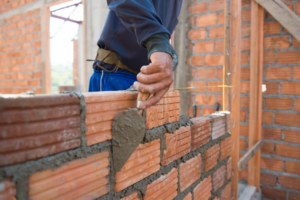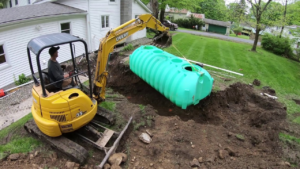Charleston Masonry is a construction technique that adds value and aesthetics to any commercial property. It also reduces energy costs by providing better insulation.
Unlike other building materials, masonry is non-combustible and requires less maintenance. It can also reduce insurance rates because it provides greater protection against fires and break-ins.

Concrete masonry is one of the most common building materials used in modern times. It is versatile, durable and relatively affordable when compared to other materials like steel or timber. It can also be recycled and used over again. It is also a non-combustible material which helps reduce fire risks. Concrete is produced by mixing aggregate, a type of rubble or crushed stone, with cement and water. The strength of a concrete mixture relies on the proportions of these three elements. Using the right volumetric mixer for concrete work ensures that these elements are mixed to the perfect consistency and therefore produces the strongest, most durable results possible.
Masonry can be found throughout the built environment, with examples including retaining walls, bridges and pavements. It is often used as a structural element but can also be clad to form the exterior of buildings. Modern technology has allowed the use of innovative masonry materials which offer enhanced energy efficiency and other benefits.
Load-bearing masonry walls are an essential part of many structures, including schools, hospitals and office buildings. Masonry is also a popular choice for façades and claddings, with designs that can reflect the surrounding context and add visual appeal to a building. Masonry products such as portland cement plaster (stucco), cements for masonry, mortars and concrete brick provide durability, safety and beauty in a cost-effective manner.
Concrete and masonry are naturally strong, but the structural integrity of a masonry structure can be further enhanced by adding reinforcements such as metal bars or wire mesh. The addition of reinforcement increases the tensile and compressive strengths of a concrete mix, making it stronger and more resistant to damage or failure.
A well-designed, properly constructed masonry structure can withstand many forces such as earthquakes and wind loads. It can also withstand the effects of corrosion caused by salt or other chemicals. Masonry is often an ideal material for structures located in flood zones, as it can be designed to withstand high water pressures.
While masonry can have an initial environmental impact due to the mining and processing of raw materials, life cycle analyses often show that its longevity and low maintenance requirements help offset these impacts. Additionally, a number of innovative technologies are being developed to improve masonry’s performance and sustainability.
Granite
Granite is a dense, hard rock that can be used for a wide variety of construction projects. It forms deep inside the Earth under a volcano or mountain when magma (melted rock) cools and crystallizes. Granite is rich in minerals, including quartz and feldspar, which give it its color and hue. Other minerals, such as mica, can introduce black or green shades into the stone. It is relatively impervious to acid and alkali, making it suitable for many applications. Granite is also incredibly strong and durable. It can withstand severe weather conditions and is resistant to frost.
Because of its durability and beauty, granite is a popular choice for countertops, floors, and outdoor masonry projects. It is also available in a number of colors, so homeowners can find the perfect look for their home or business. Granite can be used to create beautiful walkways, steps, patios, walls, and monuments. It can be cut into different shapes and sizes to fit any style of home or business, and it is easy to clean and maintain.
Masonry is a time-consuming construction method, so it can take longer to build a structure using this technique than other methods. This can result in higher construction costs. Additionally, masonry structures can be very heavy, which can require more substantial foundation designs and increase the cost of materials and labor.
The use of masonry has been an important part of architectural history, from the cathedrals of the Gothic period to the skyscrapers that defined modernism. Although modern architecture sought to break away from traditional masonry styles, it still utilized the use of blocks, bricks, and concrete.
Limestone is a natural material that can be used in a variety of ways for a masonry project. It is a popular choice for flooring and can be found in a variety of colors, textures, and patterns. It is often used in bathrooms and kitchens, but can be used for walls, steps, or even entire buildings.
One of the biggest advantages of limestone is that it is a sustainable material that provides energy efficiency and a long life cycle. It is also environmentally friendly, since it uses less energy to manufacture than other types of building materials. In addition, limestone is durable and easy to care for, so it will last a long time.
Natural Stones
Natural stone is a unique material that has been used in building construction for centuries. It is very durable and offers a unique look to any structure. Many different types of stones are available to use for masonry, and each has its own special characteristics that make it ideal for specific applications.
A natural stone is a rock that has formed naturally through the geological process. It starts out as a sedimentary rock and then is metamorphosed by heat and pressure from within the earth’s crust. It can either remain as a sedimentary rock or may be transformed into another type of rock, such as sandstone.
When a stone is masonry, it is usually placed in mortared horizontal courses, or courses of stones that are lined up together. This helps to keep the stones from shifting, and it also allows for a more consistent appearance throughout the entire project.
Stones can be arranged in several ways for masonry projects, depending on the type of design and how it is to be installed. One way is to install the stone as a veneer, which means that it isn’t a part of the structural wall. Another way is to use it as a non-structural facing that’s tied back to the structure.
Other types of stone masonry include using it as an arch, vault or dome, and abutment walls. An arch is a structural feature that supports an opening in the side of a wall. A vault is a space extending vertically from the floor of a room or building. A buttress is a support or anchor for a column or arch.
When installing stone masonry, it’s important to have a good understanding of the terminology that is associated with the process. This will help ensure that you have the correct product for the job at hand and that it is installed correctly.
Some common terms to know when installing natural stone are abutment, bond beam, back arch and spandrel. Other terms to understand are arc lintel, belt course, face cut, gable and nipple. It’s also helpful to know that natural stone is a porous material, so it will need to be sealed to resist penetration of spilled liquids.
Mortar
A combination of sand, a binding material like lime or cement and water, mortar is used in masonry building to bridge the space between brick, block, stone or concrete masonry units. It is also used to add a decorative pattern in brick or stone masonry. It can also be mixed with a latex or polymer additive to make thin-set mortar, which is used to install tile. Mortar is used as a base under tiles, and it also helps to even out the surface of the brick or stone for an easier and smoother finish.
There are a variety of mortar types used in construction, each with its own unique characteristics. Each type of mortar is designed for a specific purpose, and the strength it will reach depends on how it’s prepared and applied. A mason should follow proper mixing procedures for the best results. For example, the sand should be well mixed and not clumped together before adding the rest of the materials. It’s also important to use the correct water to cement ratio for the application. Too much water will result in a weak mortar, while too little water won’t create a strong enough bond to hold the bricks or blocks in place.
The mortar used in masonry is usually made from portland cement, although some companies now manufacture it with a hydrated lime additive to produce masonry cement. The type of mortar a mason chooses will depend on the building’s structure and environment. For example, a building with high exposure to the elements will require a mortar that has good resistance to free-thaw deterioration.
Masonry construction requires a wide range of tools, including hammers, mallets, chisels and gouges, which can be used to shape and dress the stones. They can be hand-held or powered by machines. In addition, there are various devices to handle the stone at the construction site, including different forms of frame and circular saws and surfacing machines. A mason must be familiar with all of these tools in order to properly prepare and work with them.

